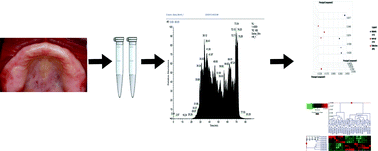Exploring salivary proteomes in edentulous patients with type 2 diabetes†
Abstract
Type 2 diabetes and tooth loss are linked both epidemiologically and pathophysiologically. We applied label-free differential

* Corresponding authors
a
Department of Prosthodontics, School of Dentistry, University of North Carolina, CB#7450, Chapel Hill, USA
E-mail:
Sompop_Bencharit@dentistry.unc.edu
Fax: +1 919-966-3821
Tel: +1 919-843-8734
b University of Mount Union, Alliance, USA
c David H. Murdock Research Institute, North Carolina Research Campus, Kannapolis, USA
d Department of Pharmacology, School of Medicine, University of North Carolina, Chapel Hill, USA
e Department of Diagnostic Science and General Dentistry, University of North Carolina, Chapel Hill, USA
f Department of Periodontology, School of Dentistry, University of North Carolina, Chapel Hill, USA
g Division of Endocrinology, Department of Medicine, School of Medicine, University of North Carolina, Chapel Hill, USA
Type 2 diabetes and tooth loss are linked both epidemiologically and pathophysiologically. We applied label-free differential

 Please wait while we load your content...
Something went wrong. Try again?
Please wait while we load your content...
Something went wrong. Try again?
M. B. Border, S. Schwartz, J. Carlson, C. F. Dibble, H. Kohltfarber, S. Offenbacher, J. B. Buse and S. Bencharit, Mol. BioSyst., 2012, 8, 1304 DOI: 10.1039/C2MB05079J
To request permission to reproduce material from this article, please go to the Copyright Clearance Center request page.
If you are an author contributing to an RSC publication, you do not need to request permission provided correct acknowledgement is given.
If you are the author of this article, you do not need to request permission to reproduce figures and diagrams provided correct acknowledgement is given. If you want to reproduce the whole article in a third-party publication (excluding your thesis/dissertation for which permission is not required) please go to the Copyright Clearance Center request page.
Read more about how to correctly acknowledge RSC content.
 Fetching data from CrossRef.
Fetching data from CrossRef.
This may take some time to load.
Loading related content
